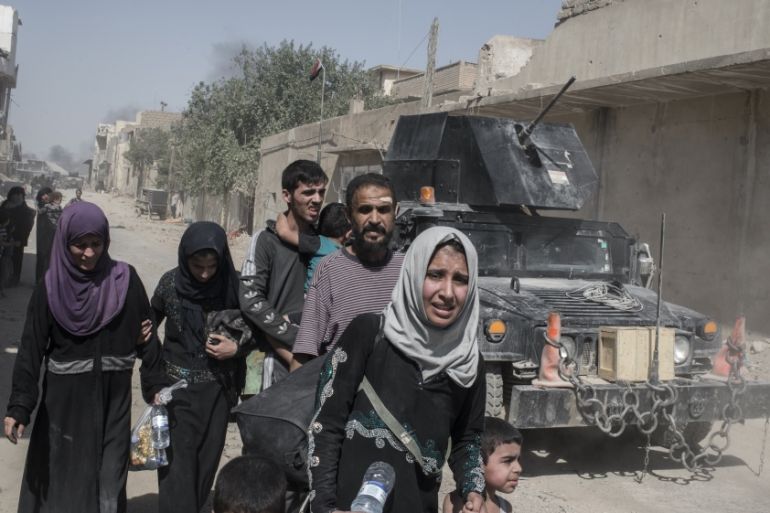The horrors of urban warfare
Urban warfare is bleeding cities dry and forcing millions on the move, but it doesn’t have to be this way.

A skyline of collapsed buildings, twisted metal dangling from the remnants. Walls peppered with shrapnel and bullet scars. An old man, dazed and confused, is picking his way through the rubble that was once his home. From Yemen to Iraq to Syria, the scene is all too familiar.
Urban warfare in today’s world is bleeding cities dry and forcing millions on the move. While the scourge of urban conflict is not unique to the Middle East, the level of suffering in places such as Aleppo, Mosul and Taiz, has reached unprecedented levels.
Keep reading
list of 4 itemsEurope pledges to boost aid to Sudan on unwelcome war anniversary
Birth, death, escape: Three women’s struggle through Sudan’s war
Does Israel twist humanitarian law to justify Gaza carnage?
Of course, urban warfare and its accompanying horrors are nothing new.
I grew up in the midst of civil war in Lebanon in the 1970s and 80s, experiencing the uncertainty of intense urban struggle. The car bombs, the killings, the shortages, and the fear.
I remember one terrible evening when a car bomb was detonated close to our home, on the road where my father used to travel. It was at exactly the time that he was supposed to be passing. The sirens, the screams, the confusion. It was the longest 10 minutes of my life before he made it home.
READ MORE: How will Mosul rise from the ashes of battle?
But the scale and impact of urban warfare today is nothing like we’ve seen before. Everything is so interconnected. The growing sophistication of urban infrastructure and services like electricity, water, sewerage, waste disposal and healthcare means that everything is more dependent than ever on complex logistics and specialist personnel. Take one part out and the whole house of cards comes tumbling down.
The International Committee of the Red Cross (ICRC) has just produced a special report, I Saw My City Die, which looks at shocking effects of modern urban warfare. It concentrates on the ICRC’s experiences in the Middle East, where much of our work is carried out, crossing front lines, trying to bring relief to city communities.
Over the past three years, our research shows that wars in cities accounted for at least 70 percent of all civilian deaths in six provinces heavily affected by violence in Iraq and Syria
The research for the report found that as many as five times more civilians die in major offensives carried out in cities than in other battles. Over the past three years, our research shows that wars in cities accounted for at least 70 percent of all civilian deaths in six provinces heavily affected by violence in Iraq and Syria.
There is one key difference that stands out between the urban fighting that I witnessed three decades ago in Lebanon and that of today. It’s the contemporary massive use of air power. The consequences for civilians and civilian infrastructure are enormous.
One paradox of modern urban warfare is the use of tactics which go back to the Middle Ages. The extensive use of siege tactics is a prime example – sealing off urban areas and forcing the population to try to survive by eating anything they can find: leaves from trees, a few grains of rice, and worse.
And the consequences of all this? Incalculable suffering, mass displacement and the largest shifts of population since the second world war. Streams of refugees. Societies and communities fractured.
It’s a depressing picture. But it doesn’t have to be this way. There are ways that this tidal wave of suffering can be alleviated. Where there is a will, there is a way.
There are “norms” of warfare that need to be followed. There is something called “international humanitarian law” which is designed to protect people from the worst elements of warfare.
READ MORE: UN: ‘Staggering’ civilian deaths in Raqqa offensive
It says neither civilians nor civilian infrastructure should be targeted; that medical and humanitarian personnel should not be harmed; that armed parties must use force that is proportionate to the circumstances; that prisoners should be treated with dignity.
States need to abide by these rules, rules that every country has signed up to. It’s just a matter of people fulfilling their promises. In addition, the ICRC strongly believes that heavy explosive weapons should not be used in densely populated areas: The impact is too devastating.
And states, and others, who have influence over parties to a conflict, need to exert their influence as well. They should tell their allies that support will not be forthcoming if they don’t abide by these norms of warfare.
Why is all this important? In the short term, it’s simply a matter of saving lives and reducing suffering. But in the long term, it’s a matter of laying the foundations for a better future. It’s a lot easier to rebuild, to reconcile, to reconstitute if the war itself was kept within some bounds, where humanitarian considerations were respected.
If not, a new generation grows up in a conflict incubator and the vicious cycle of violence continues.
It’s estimated that around 50 million people in the world today are affected by armed conflict in urban areas. Imagine how many lives could be protected and preserved if these simple actions were taken?
And the time is now. With the current, bloody, fighting around Mosul and Raqqa, it is imperative that all those involved to take the moral high ground, to show that civilian lives do matter, that there is an alternative, that humanitarian beliefs do indeed beat in the hearts of us all.
Robert Mardini is regional director for the Near and Middle East at the International Committee of the Red Cross.
The views expressed in this article are the author’s own and do not necessarily reflect Al Jazeera’s editorial policy.
